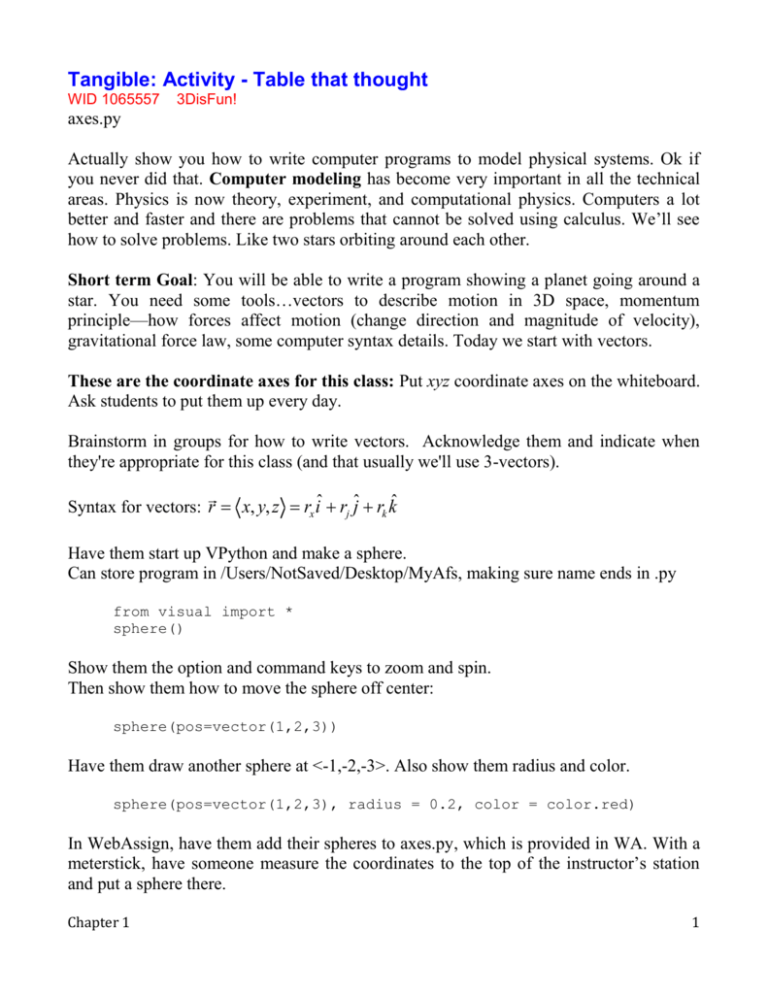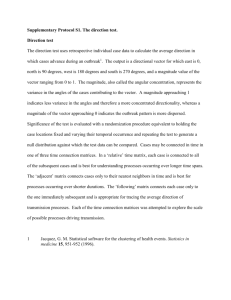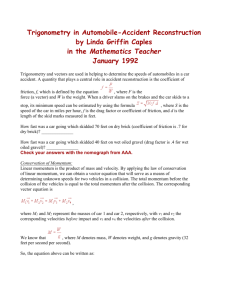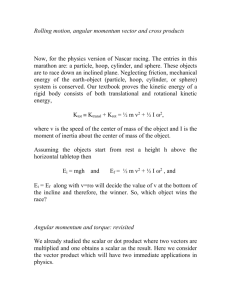Chapter 1 Notes
advertisement

Tangible: Activity - Table that thought WID 1065557 3DisFun! axes.py Actually show you how to write computer programs to model physical systems. Ok if you never did that. Computer modeling has become very important in all the technical areas. Physics is now theory, experiment, and computational physics. Computers a lot better and faster and there are problems that cannot be solved using calculus. We’ll see how to solve problems. Like two stars orbiting around each other. Short term Goal: You will be able to write a program showing a planet going around a star. You need some tools…vectors to describe motion in 3D space, momentum principle—how forces affect motion (change direction and magnitude of velocity), gravitational force law, some computer syntax details. Today we start with vectors. These are the coordinate axes for this class: Put xyz coordinate axes on the whiteboard. Ask students to put them up every day. Brainstorm in groups for how to write vectors. Acknowledge them and indicate when they're appropriate for this class (and that usually we'll use 3-vectors). Syntax for vectors: r = x, y, z = rx iˆ + rj ĵ + rk k̂ Have them start up VPython and make a sphere. Can store program in /Users/NotSaved/Desktop/MyAfs, making sure name ends in .py from visual import * sphere() Show them the option and command keys to zoom and spin. Then show them how to move the sphere off center: sphere(pos=vector(1,2,3)) Have them draw another sphere at <-1,-2,-3>. Also show them radius and color. sphere(pos=vector(1,2,3), radius = 0.2, color = color.red) In WebAssign, have them add their spheres to axes.py, which is provided in WA. With a meterstick, have someone measure the coordinates to the top of the instructor’s station and put a sphere there. Chapter 1 1 Tangible: Activity - From your table to my nose WID 1065564 zing G108.py Show them the G108.py file (model of the room). Have them download it from WebAssign and put a sphere in the middle of their table. Table1 = cylinder(pos=vector(x,y,z), axis=vector(0,0.03,0), radius=2) For fun, I add sphere(pos=vector(0,0.5,6.7), put Earth at the instructor station location. radius = 1, material=materials.earth) to Have them draw a red arrow (a) from the origin to the center of their table using the following syntax. arrow(pos=vector(0,0,0), axis=vector(x,y,z), color = color.red) pos locates tail, axis specifies vector components Have them draw a blue vector (c) from origin to tip of instructor’s nose at <0, 1.5, 4> What if we wanted distance from table to instructor? First need vector pointing from table to instructor, then find its magnitude. That brings up addition and subtraction of vectors. Not like regular numbers. a+b =c b a so b = c - a = cx - ax , cy - ay , cz - az c Now find the vector from your table to the instructor’s nose. = I - T What is its magnitude? Draw it as a green vector in VPython using syntax: arrow(pos=vector(Tx,Ty,Tz),axis=vector(Ix-Tx,Iy-Ty,Iz-Tz), color=color.green) Chapter 1 2 Tangible: It’s in the Stars WID 1065581 xyz123 BigDipper.py BigDipperData.xls BigDipperPaper.pdf (TPT article describing the activity) Have them finish drawing an arrow from Alkaid to Dubhe. Pointer = arrow(pos=Alkaid.pos,axis=(Dubhe.pos-Alkaid.pos),shaftwidth color=color.orange) print(Pointer.axis) = 0.5, They can use BigDipper.py if they want. For fun, add Earth = sphere(pos=vector(0,0,0),radius=1,material=materials.earth) How long does it take light to travel from Dubhe to Earth? rDubhe = 12.12 + 92.52 + (-48.2)2 light years = 105 light years(so, 105 years) From Alkaid to Earth? (210 light years) From Alkaid to Dubhe? Recall how to do vector addition and subtraction. We’ll come back to this (it’s 124 ly). Pointer.axis = <73.8, -66.8, 74> Make a big deal about it not being 210-105 ly. Show them how to do distance to Earth calculations with Excel and naming cells. Chapter 1 3 Named cells, x, y, and z Ponderable: Activity - Unit Vectors WID 1053004 Factoring vectors as magnitude times direction a= a so a unit vector in a particular direction is given by: â = â magnitude direction You find unit vector for <1,1,1>m. 1,1,1 m 1,1,1 m a â = = = = 2 2 2 a 3 m (1 m ) + (1 m ) + (1 m ) So a = â = a magnitude direction ( 3m ) 1 3 , 1 3 , 1 a a = 0.58, 0.58, 0.58 3 1 1 1 , , = 1,1,1 m 3 3 3 Have the even number tables calculate unit vector in the direction of <2,2,2>, odd number tables do <3,3,3>. They are all the same, of course. b̂ = b b = Chapter 1 2, 2, 2 m (2 m) 2 + (2 m) + (2 m) 2 2 = 2, 2, 2 m 12 m = 2 , 2 , 2 2 3 2 3 2 3 = 0.58, 0.58, 0.58 4 ĉ = c = c 3, 3, 3 m ( 3 m) 2 + (3 m) + ( 3 m) 2 2 = 3, 3, 3 m 27 m = 3 , 3 , 3 3 3 3 3 3 3 = 0.58, 0.58, 0.58 Find unit vector pointing from your table to the instructor’s nose (blue vector). What is its magnitude? (1, with no units) Write your instructor vector as magnitude times direction. Direction cosines cos q = A adjacent = x hypotenuse 1 so Ax = cos q x r̂ = cos q x , cos q y , cos q z Discussion: Motion in 3D Cartoon.doc rf - ri Dr t f - ti Dt Magnitude is called average speed. Memorize this! Maximum average speed of a runner? (100 m/10 s = 10 m/s) Average velocity of a marathon runner who leaves stadium, runs 26.1 miles, and returns to stadium = 0 Average velocity vavg = ( = ) rf = ri + vavg t f - ti = ri + vavg Dt Memorize this or derive from above! Actually 3 equations at once: x f = xi + vx Dt y f = yi + v y Dt z f = zi + vz Dt dr dt What is the average speed of a spaceship that flies from Alkaid to Dubhe in 372 years? (slightly relativistic) For very short time, get instantaneous velocity v = Chapter 1 5 ( ) rf = ri + v t f - ti = ri + v Dt v= v= rf - ri Dt = ( 12.1,92.5,-48.2 - -61.8,159.2,-122.2 ) light years 372 years 73.9,-66.7,74.0 light years 372 years v = 0.333 lightyearyears = = 0.199,-0.179,0.199 light years year c = 1 ´ 108 m s 3 You are the helmsman for your generation and you must steer the ship. Which way to you go? (i.e. what is the unit vector?) 73.9,-66.7,74.0 light years Dr Dr̂ = = = 0.596,0.538,0.597 124 light years Dr You are controlling the ship at the 100 year anniversary of its launch. Where are you? light years rf = ri + vDt = -61.8,159.2,-122.2 light years + 0.199,-0.179,0.199 year 100 years ( ) rf = -61.8,159.2,-122.2 light years + 19.9,-17.9,19.9 light years rf = -41.9,141.3,-102.3 light years Clickers: Chapter 1 Discussion: Position Update In question 6 above, you did what we call a “position update.” In vector form, rfinal = rinitial +vt. Link to steps walking across a room. Link to a movie at 30 fps or a flipbook. Note how the position update formula is just a rewritten form of the definition of average velocity (and you’ll be expected to memorize it as well). --Need groups assigned by now— VPython: Introduction to 3D computer modeling WID 624840 (entitled VPython Introduction) Chapter 1 igk53 6 vector.py Demo: Interactions [Note: This activity was written in the 11th hour but worked wonderfully; we used a long cylinder magnet on top of the wood and a stronger bar magnet beneath the wood. The wood was placed on top of the projector and the action was displayed on the screens. When we rolled the cylinder on the wood, it was clear that something odd was interacting. When asked what interacted with the cylinder, the students generated a fantastic list. We discussed when the hand interacted with it. We also discussed the fact that yes, light interacts with the magnet too! But that interaction causes a change in ENERGY rather than a change in momentum!] Demonstrate a ball rolling over a piece of plywood with a magnet underneath (which they can’t see). What can you tell about the motion of the ball? What has to happen to cause an object to move in a way other than a straight line at constant speed? What objects are interacting with the ball? The object has to interact with one or more other objects, either by touching them, or by action-at-a-distance, like the gravitational interaction. So in order to be able to make quantitative predictions about the motion of an object, and to be able to figure out what kind of interaction we need to produce particular kinds of motion, like curving paths, we need to find a quantitative, mathematical way of expressing the effects of INTERACTIONS on MOTION. Tangible: Momentum Equipment: tennis ball, medicine ball Need 2 volunteers: Student 1 throws tennis ball and medicine ball/bowling ball to student 2; which is easier to throw? Why? which is easier to catch? Why? m matters in mv Chapter 1 7 Discussion: Momentum Define momentum as p= mv, p is ALWAYS!! in the same direction as v. It turns out (by which we mean: the results of many different kinds of experiments done by many different scientists over many years lead to the conclusion that) the quantity that is altered by interactions is not simply velocity. It is momentum. Today what we’ll do is define momentum and try to get a feel for orders of magnitude, and then we’ll be ready to start exploring how interactions can change momentum. Define relativistic momentum: It is important to emphasize this form, with absolute value bars: 1 p º g mv = g m vx , vy , vz where g º 2 ævö 1- ç ÷ è cø NOTE: Students must memorize (exactly) along with the relation among displacement, velocity, and time. rf = ri + v Dt . Show the resources page. Ponderable: Calculating gamma.xls Correction factor, table by table. Table 1 does v/c = 10%, 2 does 20%, etc. Difficulties for tables 10 and 11. Show in Excel. Do calculation for 0.9995c. Even in this high-speed situation, what can you say about the direction of the momentum compared to the direction of the velocity? Ponderable: Activity - Momentum WID 1019708 TVeV All students calculate momentum of electron in TV set (25kV), moving at 3e7 m/s in the x direction, 0.1c. Chapter 1 8 p= 1 æ vö 1- ç ÷ è cø 2 mv = 1 1 - 0.1 2 ( 9.1 ´ 10 -31 ) kg 3 ´ 10 7 , 0, 0 m s p = (1.005 ) 2.73 ´ 10 -23 , 0, 0 kg m s p = 2.74 ´ 10 -23 , 0, 0 kg m s A Groups: Students calculate the momentum of a fast runner: 70 kg, 10 m/s p = 700 kg m/s B Groups: Students calculate the momentum of a baseball: 155 grams, 45 m/s p = 7 kg m/s C Groups: Fastest man-made object, Voyager 1 17,200 m/s (38,500 mph), mass is 1 ton p = (2000 lb)(1 kg/2.2 lb)(17200 m/s) = 1.56e7 kg m/s Ponderable: Activity - Change in Momentum Change in Momentum Pretest (ungraded for group roles) WID 575917 WID 575914 WID 575916 4skeptic 4manager 4recorder Activity - Change in Momentum WID 575924 momprincip Each group member does an individual pretest followed by a group assignment. First two questions on money and salary. Next two on momentum and change in momentum. Question 5 uses momentum principle to calculate force. Chapter 1 9







